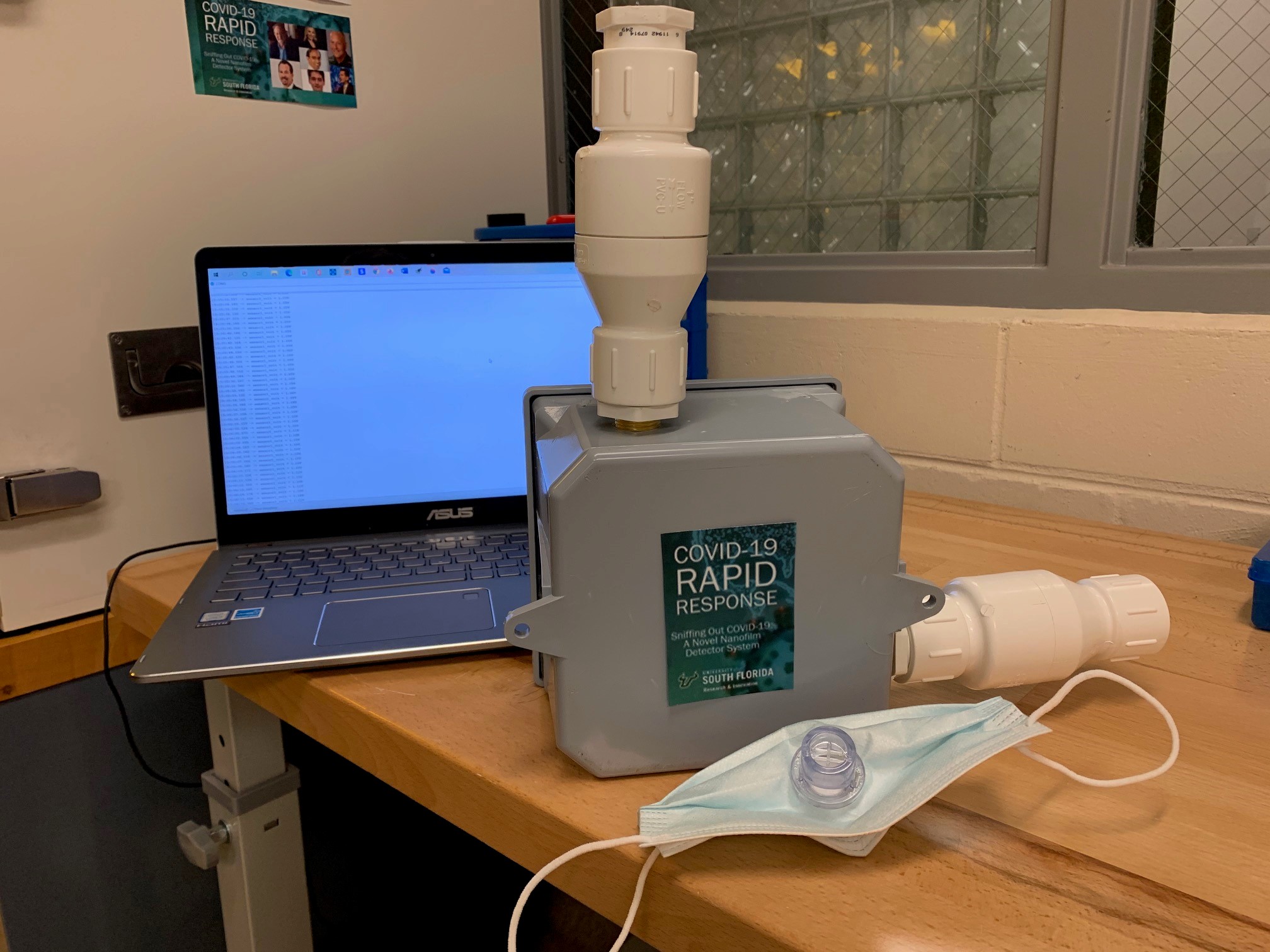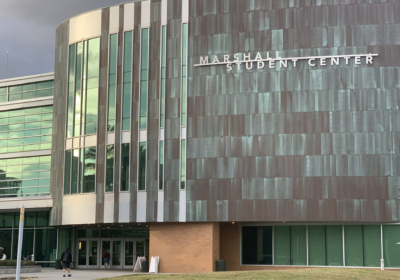Breathalyzer-style rapid COVID-19 test developed by USF researchers

At her son’s doctor’s appointment, engineering Ph.D. student Tiffany Miller watched him as his eyes widened with terror when the doctor came into the room carrying a 6-inch long nose swab for a COVID-19 test.
After having to wait for more than 17 days for the results, Miller realized the need to develop a faster, nonintrusive device to detect the presence of the virus. This experience consequently led to a partnership between USF researchers to create a device, similar to a breathalyzer, capable of detecting components of COVID-19 through an individual’s breath.
Known as “Bull Nose,” the electronic device acts as an initial screening tool and consists of sensors that detect the levels of volatile organic compounds (VOC) in the breath specific to SARS-CoV-2, the virus that originated COVID-19.
“If we could take an exhaled breath and then bring it over to the science laboratory and have them analyze it on their mass spectrometer, they could look at the elements contained within the breath,” USF College of Engineering professor Salvatore Morgera said.
“Now, if you have an infection, the nature of your breath changes, the constituents change. So, the Bull Nose basically takes a look at an exhalation of an individual … and we analyze the breath.”
The device contains a disposable mouthpiece where the exhaled breath goes through electrochemical sensors, also known as gas sensors.
As the breath flows across, the gas sensors will detect a voltage change when in contact with one of the target gases of acetone, hydrogen or carbon monoxide, according to Miller. The data collected will then be stored in a computer database and analyzed if the resulting pattern is recognized as the breath pattern signature of COVID-19.
The infectious breath then evacuates the device after going through a HEPA filter and is treated by ultraviolet light for a certain period of time.
“We’re utilizing that UV technology as well, and the UV light is capable of destroying any contaminants on the inside of the chamber as well. And we’re working in collaboration with other departments to add a filtration system to the exhaust portion,” Miller said.
Morgera said the device will then analyze the breath and detect the VOC levels within a minute.
“It’s an electronic system and the sensors will respond immediately to an exhaled breath, and they’ll give you a feeling for what the constituents are,” Morgera said.
For Morgera, the “Bull Nose” will give individuals a nonintrusive alternative to the common nose swab test, something that was a cause of discomfort for many people tested for COVID-19.
“I’m a firm believer that there are many things that can be done, maybe not everything, but there are many things that can be done without invading the person, and the swab is actually an invasive sort of procedure,” Morgera said.
The device is also an “inexpensive” tool to analyze the data and deliver an accurate diagnosis of each individual when it comes to COVID-19, according to Morgera. He said each device costs around $100 to assemble.
“To make the equipment, we spent about $100,” Morgera said. “If you were to actually go ahead and create a product or have someone else create a product and then sell it as a medical device, it would probably sell as $20,000. And of course, they’d make it. They’d seal it. They’d exhaust it properly. I mean we are doing the best we can, but it’s still a prototype device.
“I believe ours is fast, it’s inexpensive. And it’s less likely to contaminate anyone.”
Due to its method and effectiveness, the “Bulls Nose” was selected as a semifinalist for the XPRIZE Rapid Covid Testing, a $5 million, 6-month competition to develop faster, accessible and affordable COVID-19 testing methods at scale, according to its website. The project was one of the 284 semifinalists selected among a total of 4,000 applicants.
“It’s kind of a big deal,” Morgera said. “I’m very happy for the team, certainly happy for the students.”
The “Bull Nose” is among 42 other COVID-19 research projects that were selected to receive seed funding from the university as part of its COVID-19 Rapid Response Research Grants program.
The program was created to fund research on potential treatment, technologies and social mitigation strategies as a result of COVID-19 and, so far, has distributed over $1 million to fund different projects across colleges.
“We’re looking at, we’ve submitted several additional grants for further funding that will be required for us to move to the next phase in development so hopefully we can get some responses and get some additional grants issued, and we’ve been submitting our research for publication and into various conferences and additional speaking engagements,” Morgera said.
The team was selected in April during the program’s first round and received an initial grant of $25,000, according to Morgera.
Now, Morgera said they are applying for different grants and competitions, including the XPrize, National Institute of Health and the Special Operations Command at MacDill Air Force Base, to receive additional funding in the coming years to further advance their technology.
As a result of COVID-19, Morgera said the team has been assembling the device both at home and in the lab. To build one device, he said it took about 100 hours over a period of two weeks.
So far, the device has only been tested in laboratories at the College of Engineering with a synthetic virus, which is noncontagious and mimics some of the characteristics of COVID-19.
Miller said they are currently in the calibration phase to expose the sensors to pure gas standards, including carbon monoxide and acetone, to test their accuracy. After this phase, they will start introducing the device in clinics.
“Once we have gotten through the calibration phase of the prototype, then we will be having the prototype enter the clinical setting to where we can really gather some real breath data, as opposed to more of a simulated, phantom study,” Miller said.
Besides analyzing the breath, Morgera said the team is working to develop a new technology to measure changes in the eyes, nose and brain caused by SARS-CoV-2.
“We also take a look at the eye, we have a little device that scans the eye because it turns out COVID-19, especially for the serious cases, has an impact on our nervous system,” Morgera said. “And it can in fact cause what we call lesions or plaques in the brain, similar to people that suffer multiple sclerosis.
“If you have COVID-19, and it’s a serious situation, there may be an indication in the eye because it also attacks the nervous system in a similar way. So we have this little thing that scans, and we’ll take an exhaled breath, we’ll scan the eye, everything is noninvasive and I think the accuracy increased immensely by doing both.”
For Miller, having a device like the “Bull Nose” has the potential to even mitigate the risks of spreading COVID-19 to a broader community.
“The whole benefit of a rapid test result is that if you are indeed infected, you can have that information and you can quarantine and isolate rather than going to the grocery store and infecting thousands of people,” Miller said. “That really was the motivation, at least for me to get involved in this type of field of research at USF.”






